As an Amazon Associate KitchenwareSets.com earns from qualifying purchases.
11 Earthy Kitchen Ideas To Create A Warm Natural Space
Have you ever stood in your kitchen and felt… nothing? It’s functional, sure. The appliances work, the counters are clean, but it lacks a soul. It feels less like the heart of your home and more like a sterile, generic space that could be in any house, on any street. You find yourself scrolling through images of kitchens that feel different—kitchens that are bathed in soft light, filled with rich textures, and seem to radiate a calm, grounding energy.
This disconnect is a common feeling. Many modern kitchens, in their pursuit of sleek minimalism, can end up feeling cold and impersonal. They lack the warmth and character that makes a space truly feel like your own. You crave a sanctuary, a place that feels connected to the natural world, a room that invites you to slow down, take a deep breath, and feel truly at home. You want a kitchen that doesn’t just serve meals, but also nourishes your spirit.
An earthy kitchen design creates a warm and inviting atmosphere by harmonizing organic elements, natural materials like wood and stone, and a soothing color palette inspired by nature. This style emphasizes a connection to the outdoors, promoting tranquility and well-being in the heart of the home. As a design strategist, I’ve seen firsthand how connecting a kitchen to natural elements doesn’t just change the look of a room—it changes how you feel within it. It’s about crafting a space that is both beautiful and deeply restorative.
What Are the Key Elements of an Earthy Kitchen?
The key elements of an earthy kitchen are a nature-inspired color palette, the use of natural materials, maximizing natural light, and incorporating greenery. These pillars work together synergistically to create a cohesive and tranquil space that feels both grounded and refreshingly alive. Understanding these core components is the first step to transforming your kitchen.
- The Color Palette: Think of the colors you’d find on a walk in the woods. This includes warm neutrals like beige and cream, rich browns, and calming greens like sage and olive. Accents of terracotta, clay, and burnt sienna add warmth and depth.
- Natural Materials: This is the heart of the earthy style. Prioritize materials like wood for cabinetry, stone (like granite or quartzite) for countertops, and clay or ceramic for backsplashes and decor.
- Abundant Light: Natural light is crucial. It makes the space feel airy and highlights the beautiful textures of the organic materials. Large windows, glass doors, and even skylights are key features.
- Bringing Nature Indoors: This is the finishing touch that brings the design to life. Incorporating houseplants, fresh herbs on the windowsill, and decor made from natural finds like driftwood or stone forges a direct link to the outdoors.
11 Earthy Kitchen Ideas to Create Your Natural Haven
Ready to move from dreaming to doing? Here is a gallery of inspiration designed to help you craft your own natural haven. Each of the following 11 ideas is broken down into a simple, actionable format, complete with stunning visuals to help you envision the look in your own home. Whether you’re planning a full renovation or just a weekend refresh, you’ll find an idea here to infuse your space with warmth and character.
1. Embrace the Warmth of Natural Wood Cabinetry
The most effective way to establish an earthy foundation is by embracing natural wood cabinetry. Unlike painted surfaces, the unique grain and tone of wood provide an unparalleled sense of warmth and organic texture, instantly grounding the entire space. It’s a timeless choice that connects the kitchen directly to the natural world.
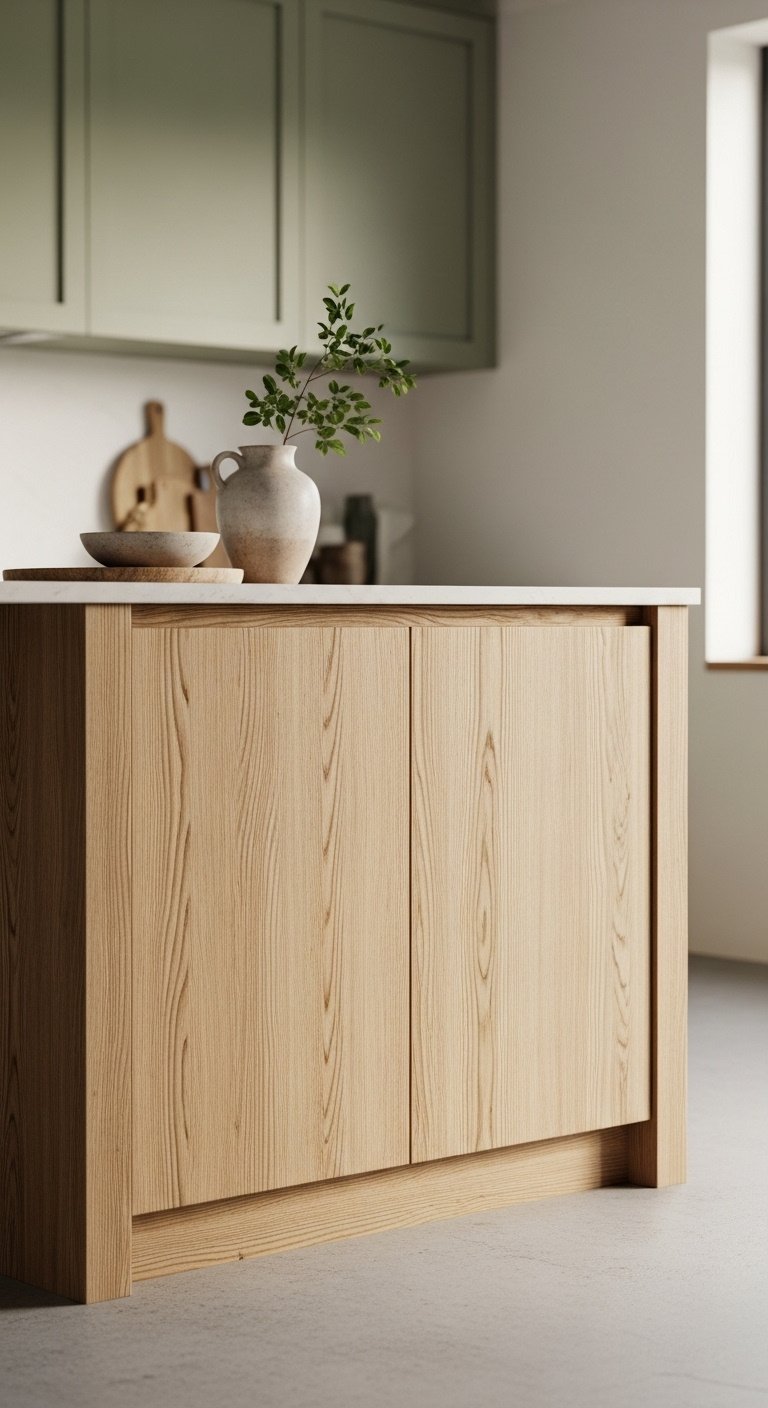
- Materials Needed: Wood cabinet samples (e.g., light oak, walnut, reclaimed pine), hardware samples (bronze, copper, matte black), cabinet cleaner, wood conditioner.
- Step-by-Step Directions:
- Select Your Wood Tone: Choose lighter woods like oak or maple for an airy, Scandinavian feel, or richer woods like walnut for a moody, sophisticated look. Reclaimed wood adds instant rustic character and a story to your space.
- Choose a Simple Door Style: Opt for flat-panel or simple shaker-style doors. This modern approach allows the natural grain and texture of the wood to be the star of the show without looking dated.
- Pair with Contrasting Hardware: Select hardware that complements the wood’s undertones. Matte black offers a sharp, modern contrast, while oil-rubbed bronze or unlacquered copper adds a layer of lived-in warmth.
- Maintain the Finish: Protect your investment. Regularly clean and condition the wood with a quality, non-toxic product to protect it from moisture and enhance its natural luster and depth.
Pro-Tip: “When choosing a wood, pay close attention to the grain pattern. A straight or rift-sawn grain offers a more modern, clean, and uniform look, while a cathedral or plain-sawn grain feels more traditional and rustic, with classic ‘arch’ patterns.”
Pin this wood cabinet inspiration for your dream kitchen board!
2. Ground Your Space with Natural Stone Countertops
To add a powerful sense of permanence and natural beauty, choose countertops made from real stone. Materials like granite, quartzite, or marble bring the textures and tones of the outdoor landscape directly into your home, providing a durable and timeless surface with unique character that can’t be replicated.
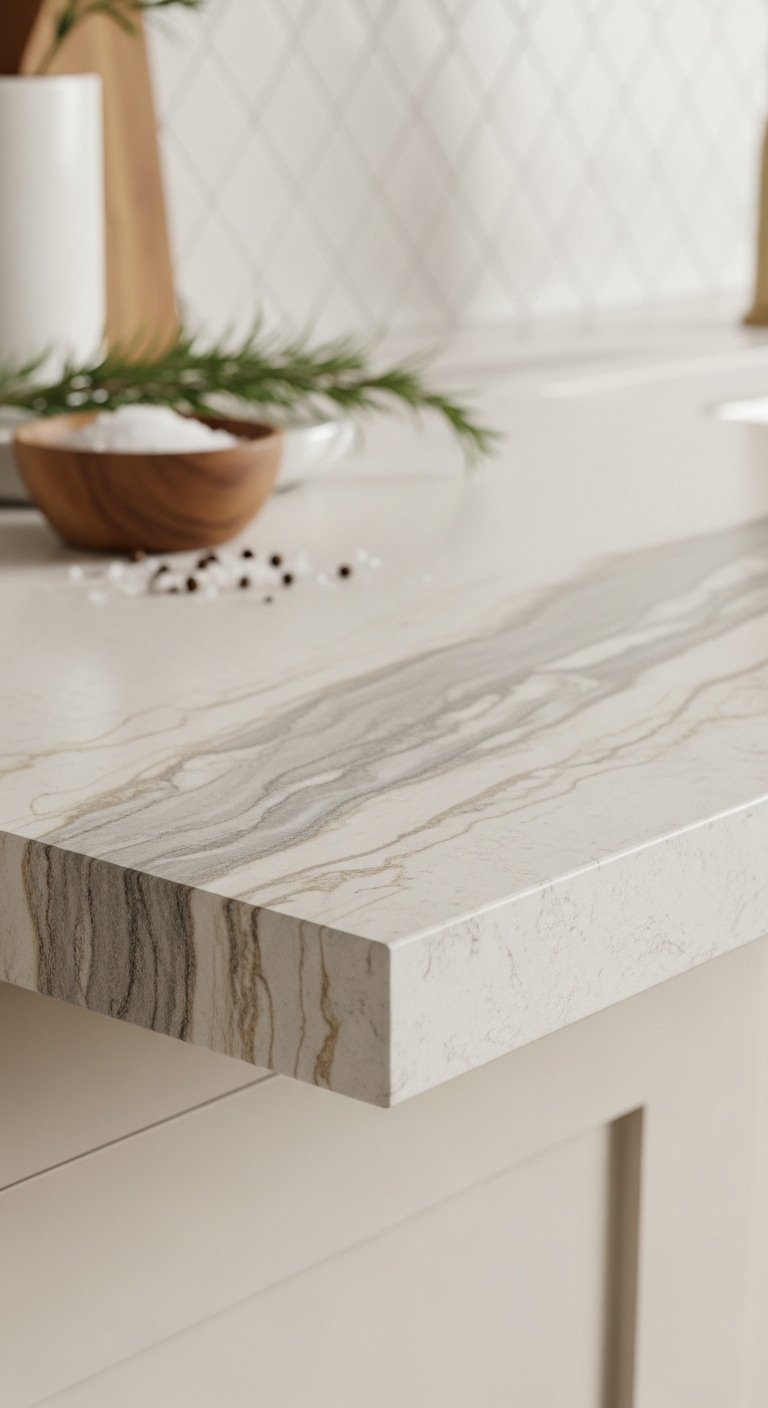
- Materials Needed: Stone samples (granite, marble, quartzite), microfiber cloth, pH-neutral stone cleaner, stone sealer.
- Step-by-Step Directions:
- Choose Your Stone: Select granite for its incredible durability and vast range of unique patterns. Choose marble for its classic, elegant veining, but be mindful of its porous nature. For a durable, marble-like look, consider quartzite.
- Consider the Finish: A honed (matte) finish provides a soft, organic look that is excellent at hiding fingerprints and has a wonderfully tactile quality. A polished finish reflects more light and makes the stone’s depth and colors pop.
- Select a Slab with Character: This is a crucial step. Visit a stone yard to hand-pick your exact slab. Look for veining and tones that speak to you and mimic natural landscapes—sandy beige, deep charcoal, or even tones with mossy green flecks.
- Seal for Protection: Natural stone is porous to varying degrees. Ensure your countertop is properly sealed upon installation and learn the recommended re-sealing schedule from your installer to protect it against stains and etching.
Lesson Learned: “Always test a sample of your chosen stone with common kitchen spills like lemon juice, red wine, and oil before you commit. Leave them on for a few minutes, then wipe away. This gives you a real-world understanding of its durability and maintenance needs beyond the sales pitch.”
Save this stunning countertop idea for your renovation plans!
3. Paint with a Nature-Inspired Color Palette
The quickest way to evoke an earthy feeling is by painting with a nature-inspired color palette. The right colors can instantly transform a kitchen’s atmosphere, making it feel warmer, calmer, and more connected to the outdoors. Think less about fleeting trends and more about the timeless colors of the natural world.
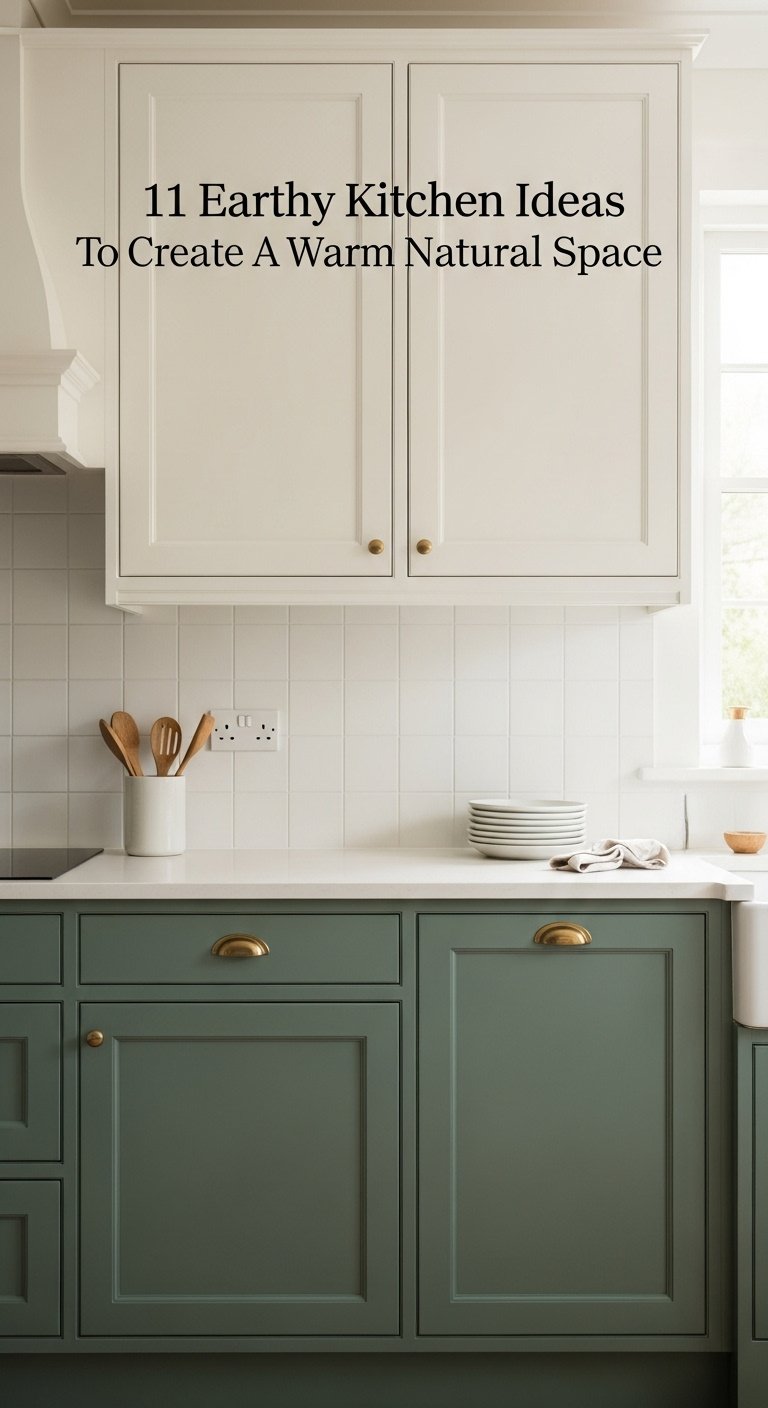
- Materials Needed: Paint swatches/samples in earthy tones, painter’s tape, paint roller, paint brushes, drop cloth.
- Step-by-Step Directions:
- Choose a Base Neutral: Start with a soft, warm base for your walls, like a creamy off-white, a soft beige, or a muted greige (a mix of grey and beige). This creates a bright, airy foundation that allows other elements to shine.
- Select an Earthy Hue: Pick a richer earth tone to use on cabinets or as a statement-making accent wall. Popular choices for 2025 include soft sage green, deep olive, muted terracotta, and rich mushroom brown.
- Test Your Colors: This is non-negotiable. Always paint large swatches (at least 2×2 feet) on your walls or on poster boards. Observe them at different times of the day—morning, noon, and night—to see how the natural and artificial light affects the color.
- Opt for a Matte Finish: A matte or eggshell paint finish absorbs light, which enhances the soft, organic feel of the color palette. It reduces glare and gives the color a velvety, rich appearance.
Pro-Tip: “Pair a deep, earthy cabinet color like olive green with warm white walls and aged brass hardware. This classic combination feels both incredibly sophisticated and wonderfully grounded, a perfect balance for a modern earthy kitchen.”
Which earthy color is your favorite? Pin your choice!
4. Bring the Outdoors In with Abundant Greenery
To literally breathe life into your kitchen, bring the outdoors in with abundant greenery. Plants not only improve air quality and reduce stress, but they also add a vibrant, living element that instantly connects your indoor space to the natural world. A kitchen with plants feels fresh, dynamic, and full of positive energy.
@lisa.kanegae If this is your vibe….lets be friends #interiordesign #interiordesigns #kitchenremodel #kitchenremodeling #diningroomdecor
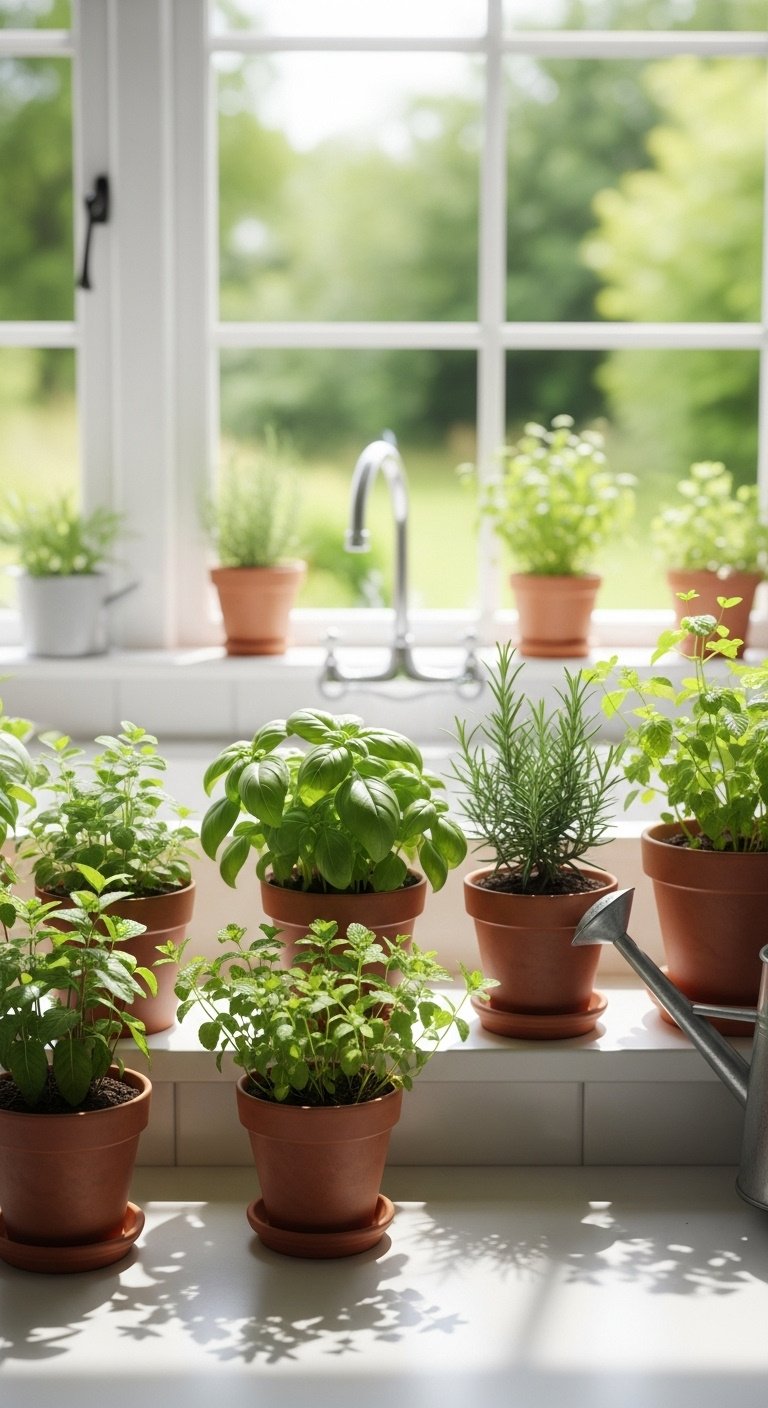
- Materials Needed: Assorted houseplants (pothos, snake plant, spider plant), fresh herbs (basil, mint, rosemary), terracotta or ceramic pots, potting mix, small watering can.
- Step-by-Step Directions:
- Create a Windowsill Herb Garden: This is both beautiful and functional. Plant culinary herbs like basil, rosemary, mint, and thyme in small pots and line them up on your sunniest windowsill for easy access while cooking.
- Style with Trailing Plants: Place a low-maintenance trailing plant like a Golden Pothos or Philodendron on top of your cabinets or on a high open shelf. Their cascading vines create a beautiful, lush effect.
- Use Larger Potted Plants: If you have an empty corner or some floor space, add a larger potted plant like a Fiddle Leaf Fig, a Snake Plant, or a Monstera to make a bold, sculptural, natural statement.
- Hang ‘Em High: To save precious counter space, use macrame or leather plant hangers to suspend plants like ferns or spider plants near a window. This draws the eye upward and adds a layer of bohemian charm.
Lesson Learned: “Start with low-maintenance, ‘hard-to-kill’ plants like snake plants, ZZ plants, or pothos if you’re new to plant care. They are very forgiving about watering schedules and light conditions but add just as much green beauty and life to your space.”
Add this green kitchen idea to your “Home Oasis” board!
5. Add Character with a Textured Tile Backsplash
A great way to add personality is with a textured tile backsplash. Instead of a flat, uniform surface, choose tiles with inherent texture, color variation, and an imperfect, handmade quality. This single element can become the artistic focal point of the kitchen, adding a rich layer of character and tactile appeal.
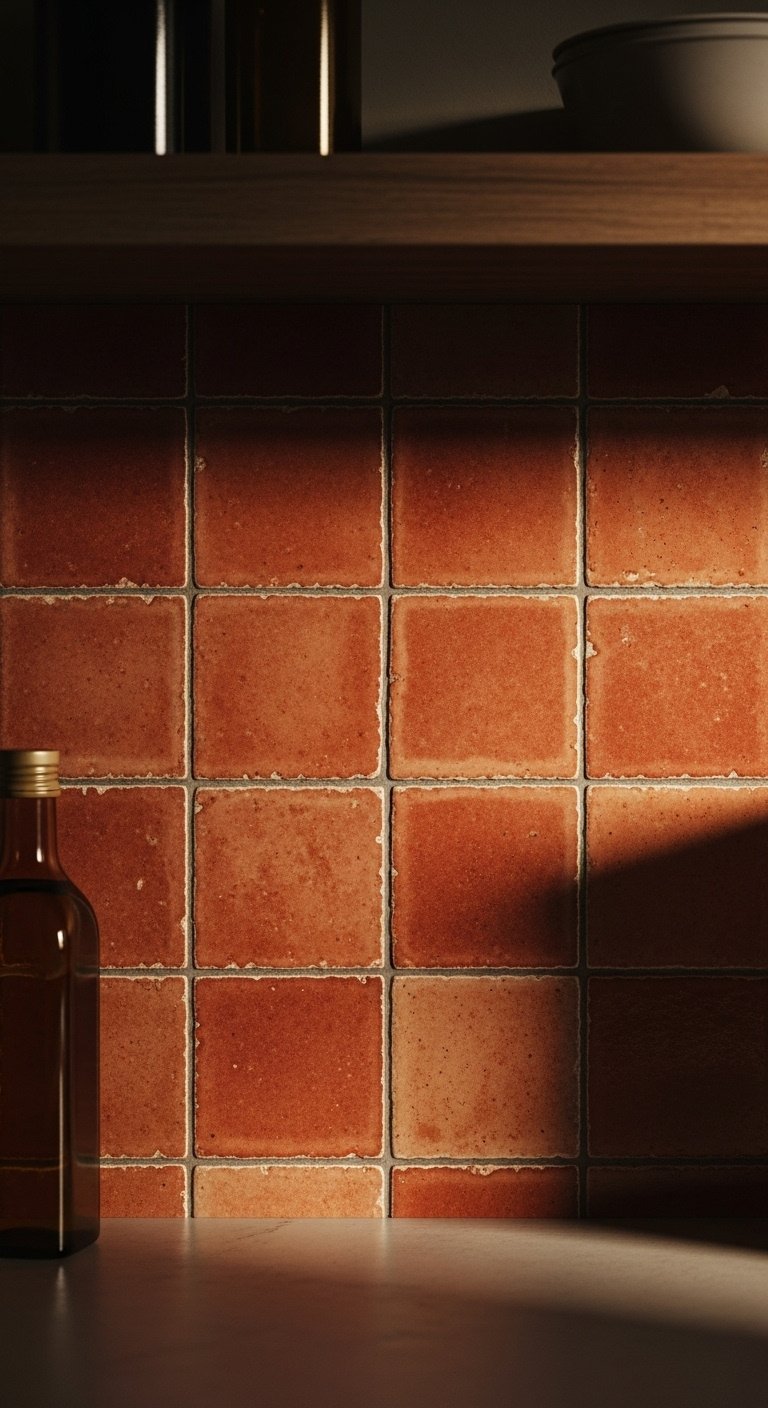
- Materials Needed: Tile samples (Zellige, terracotta, slate), grout color samples, tile adhesive, notched trowel, grout, grout float, sponge.
- Step-by-Step Directions:
- Choose a Handmade-Look Tile: Opt for tiles known for their slight imperfections and beautiful variations in color, like Moroccan Zellige or Italian Cotto tiles. This creates a rich, layered look that machine-made subway tiles simply can’t replicate.
- Consider Natural Materials: Terracotta tiles bring instant warmth and a rustic, Mediterranean feel. Natural slate, used as a full-height backsplash, offers a darker, moodier, and highly textural option that pairs beautifully with wood.
- Select a Grout Color Thoughtfully: Use a grout color that closely matches the average tone of the tile to create a seamless, monolithic look that emphasizes the tile’s texture. A slightly contrasting grout will highlight the unique shape and outline of each individual tile.
- Lay in a Classic Pattern: Let the tile be the star. Install it in a simple, timeless pattern like a straight stack (for a modern feel) or a classic running bond to let the inherent texture and color variation of the tiles shine.
Pro-Tip: “When using Zellige tiles, you must embrace the imperfections—it’s the entire point! The charm is in the slight variations in thickness, the tiny pits in the glaze, and the subtle shifts in color from tile to tile. Don’t strive for perfect uniformity.”
Pin this gorgeous backsplash for your future kitchen!
6. Style Open Shelving with Natural Finds
For a look that is both personal and airy, style open shelving with natural finds. Open shelves are the perfect place to curate a display that reflects your personality. In an earthy kitchen, this means showcasing items that are beautiful, functional, and connected to the natural world, from handmade pottery to simple wooden bowls.
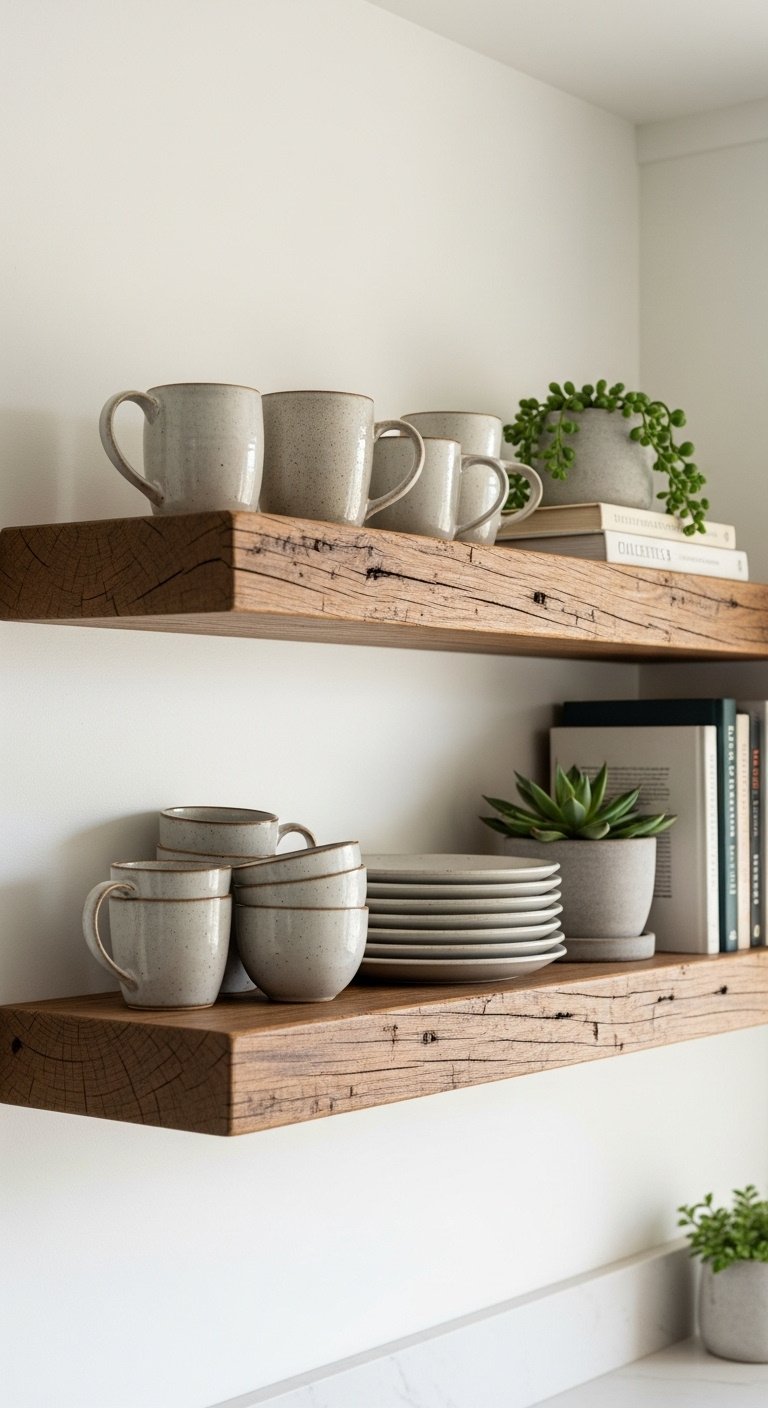
- Materials Needed: Reclaimed wood or solid wood planks, floating shelf brackets, level, drill, stud finder, curated decor items.
- Step-by-Step Directions:
- Install Natural Wood Shelves: Use thick planks of reclaimed wood or solid oak for a substantial, organic look that feels robust and authentic.
- Curate Your Display: The key is curation, not clutter. Select a mix of everyday items (like beautiful handmade stoneware plates) and purely decorative objects (like vintage pottery or a small potted plant).
- Mix Textures and Heights: Combine different materials like wood, ceramic, glass, and metal. Create visual interest by varying the height of objects—stack some bowls, lean a small cutting board against the wall, and stand cookbooks upright.
- Stick to a Cohesive Palette: To ensure your shelves look styled and not messy, choose items that fall within your kitchen’s overall earthy color palette. This creates a harmonious and intentionally curated display.
Lesson Learned: “A common mistake with open shelves is lining everything up in a single, straight row. Instead, create small groupings or ‘vignettes’ on each shelf. For example, a stack of three bowls, a small vase, and a leaning cookbook creates a much more natural and professionally styled look.”
Love this look? Save it to your ‘Kitchen Styling’ board!
7. Install Statement Lighting with Organic Materials
An easy way to add a sculptural focal point is to install statement lighting made from organic materials. The right light fixture can act as the jewelry of the kitchen, tying the whole design together. Choosing fixtures made from natural fibers adds another crucial layer of texture and warmth, even when the light is off.
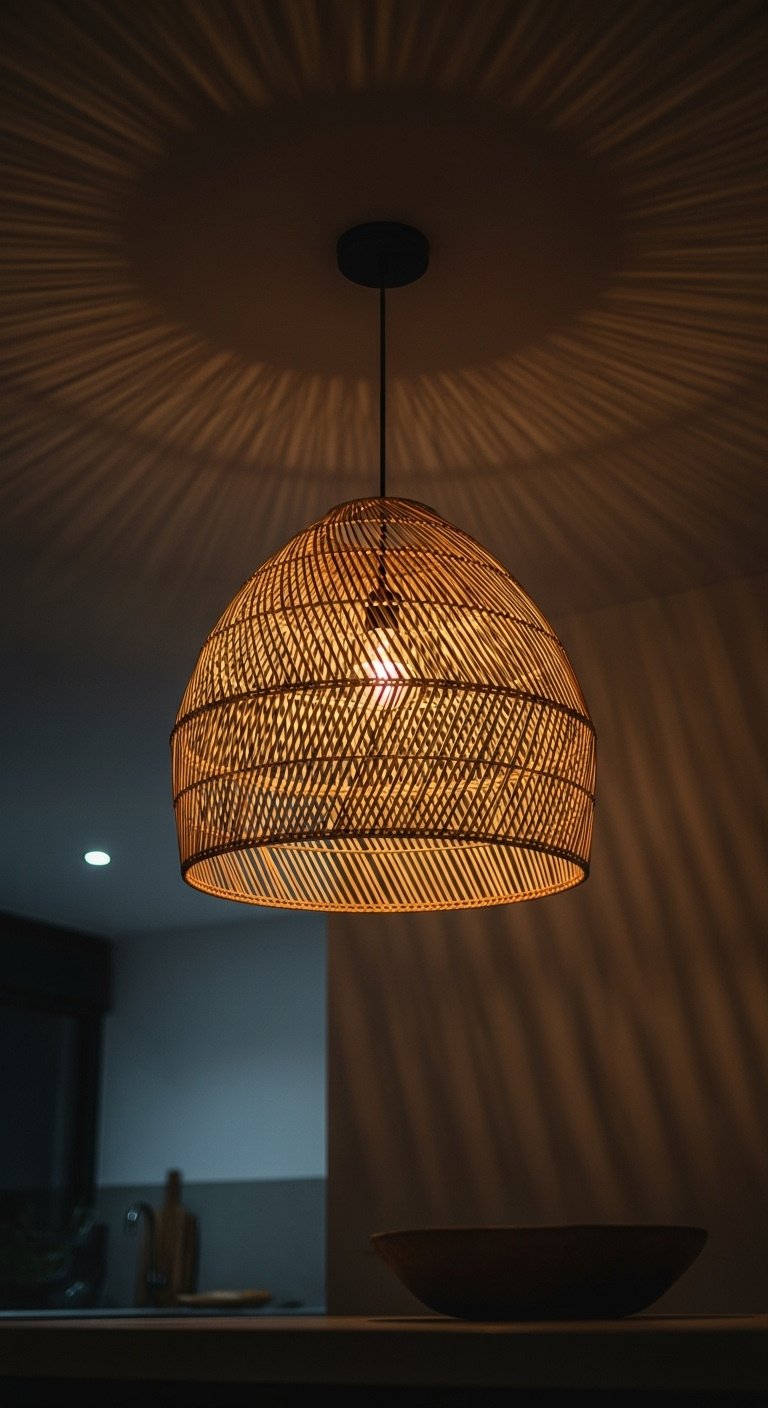
- Materials Needed: Woven pendant light fixture, warm-toned LED bulb (2700K), ladder, basic electrical tools (wire strippers, voltage tester).
- Step-by-Step Directions:
- Choose a Natural Material: Look for pendant lights or chandeliers made from materials like rattan, wicker, jute, bamboo, or even wood beads. These materials add incredible texture and diffuse the light beautifully for a soft glow.
- Go Big Over an Island: If you have a kitchen island, this is the perfect place for a statement piece. Hang one large, sculptural pendant or a linear series of two or three smaller ones to create a stunning focal point.
- Use a Warm Bulb: The light bulb choice is absolutely crucial. Use a warm white LED bulb (around 2700K) to cast a soft, inviting, candle-like glow rather than a harsh, cool, blue-toned light.
- Layer Your Lighting: Don’t rely on just one overhead fixture. Combine your statement pendant (ambient lighting) with functional recessed lighting and under-cabinet task lighting for a beautifully lit and highly practical kitchen.
Pro-Tip: “Pay close attention to scale. A pendant that is too small for the space will get lost and look insignificant, while one that is too large can overwhelm the room. As a general rule, measure the width of your island and choose a fixture that is about 1/2 to 2/3 of that width.”
Light up your kitchen! Pin this idea now.
8. Soften the Space with Organic Fiber Textiles
To add a final layer of comfort, soften the space with organic fiber textiles. Hard surfaces like stone, wood, and tile dominate a kitchen, so adding soft textiles is essential for creating balance, absorbing sound, and making the room feel cozy and inviting.
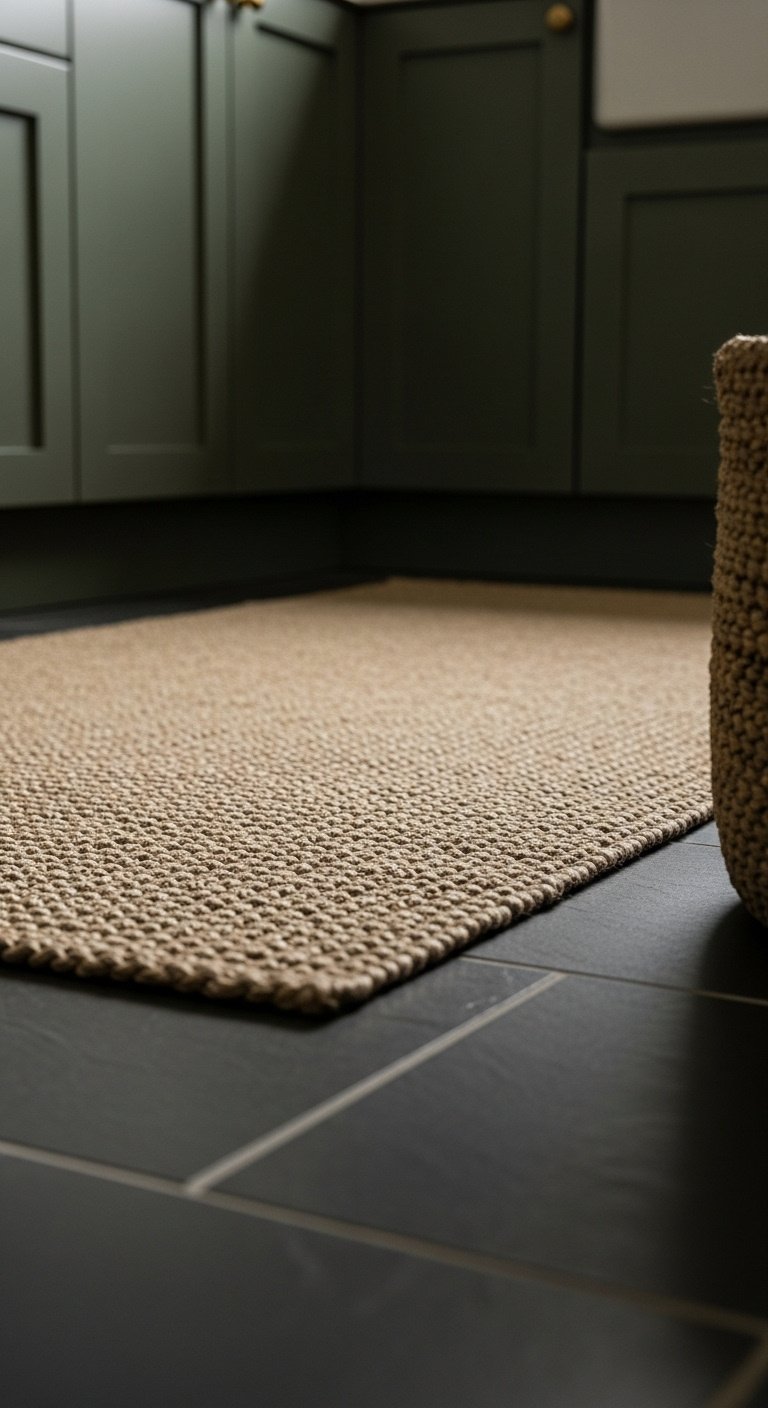
- Materials Needed: Jute or sisal runner, linen cafe curtains, cotton or linen dish towels, cushion covers for barstools.
- Step-by-Step Directions:
- Lay Down a Natural Fiber Rug: Place a durable runner made of a natural fiber like jute or sisal in the main walkway, typically in front of the sink. It adds incredible texture, defines the workspace, and feels great underfoot.
- Hang Breezy Curtains: If you have a kitchen window that needs a covering, swap heavy drapes for light and airy linen cafe curtains or a simple Roman shade. They soften the hard lines of the window without blocking precious natural light.
- Drape Natural Dish Towels: This is an easy and inexpensive upgrade. Choose high-quality dish towels made from absorbent cotton or wonderfully textured linen in earthy colors or with subtle, nature-inspired patterns. Drape one over your oven handle or sink for a touch of effortless style.
- Add Cushioned Comfort: If you have bar stools or a breakfast nook with a bench, add comfortable cushions with covers made from organic cotton or a durable linen blend to add a welcome layer of softness.
Lesson Learned: “Jute rugs are wonderfully textural, but they can shed a bit initially. A quick vacuum when you first unroll it and regular light vacuuming (without the beater bar) will keep it looking great and minimize the natural shedding.”
Add a touch of texture! Save this textile idea.
9. Incorporate Warm Metal Accents
To add a touch of modern sophistication, incorporate warm metal accents. Metals provide a beautiful contrast to the raw, natural materials in an earthy kitchen. Choosing warm-toned metals or a grounding matte black finish will complement the overall design and add a touch of polished elegance.
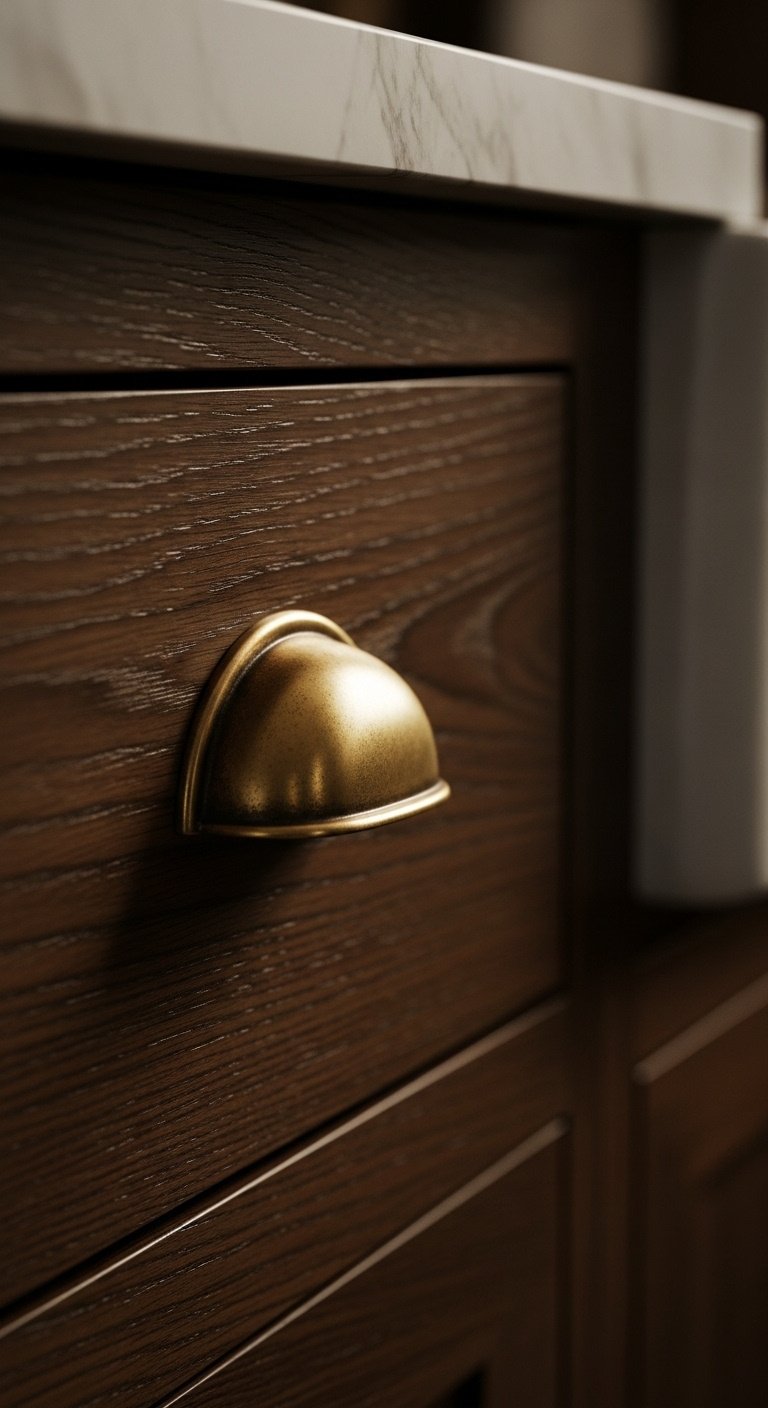
- Materials Needed: Metal hardware samples (aged brass, oil-rubbed bronze, matte black), new cabinet hardware, screwdriver, faucet.
- Step-by-Step Directions:
- Choose Warm Tones: Opt for metals like aged brass, copper, or oil-rubbed bronze for your cabinet hardware and faucet. These have a warmth that pairs beautifully with wood cabinets and earthy paint colors.
- Consider Matte Black for Modern Contrast: For a more modern or industrial take on the earthy look, use matte black for your faucet, hardware, and light fixtures. It provides a sleek, grounding contrast to the softer, natural textures.
- Embrace a Living Finish: For ultimate character, choose unlacquered brass or copper hardware. These metals are designed to develop a beautiful, natural patina over time with use, adding a sense of history and story to your kitchen.
- Mix Metals Thoughtfully: You can absolutely mix metals, but do it with intention. A common and successful strategy is to use one metal for your hardware (knobs and pulls) and another for your plumbing fixtures and lighting.
Pro-Tip: “Before you invest in all new hardware for your cabinets, consider a budget-friendly update first. Try spray painting your existing knobs and pulls with a high-quality metallic or matte black paint. It’s a simple DIY that can have a huge impact.”
Pin this perfect hardware pairing for your cabinets!
10. Maximize and Soften Natural Light
To make your kitchen feel alive and airy, you must maximize and soften natural light. Light is one of the most powerful tools in design. In an earthy kitchen, it highlights the textures of natural materials and reinforces the connection to the outdoors, making the entire space feel bigger, brighter, and more welcoming.

- Materials Needed: Sheer linen or cotton curtains, glass cleaner, mirror (optional), information on skylight installation.
- Step-by-Step Directions:
- Keep Window Dressings Minimal: If privacy allows, leave your kitchen windows completely unadorned. If you need a covering, use sheer linen curtains or a simple woven wood roman shade that can be fully raised during the day to avoid blocking any light.
- Clean Your Windows Regularly: This sounds incredibly simple, but it makes a significant difference. Sparkling clean windows can dramatically increase the amount and quality of light that enters your kitchen.
- Use Strategic Reflection: While you want to avoid an overly glossy look, a backsplash tile with a slight, subtle sheen or a thoughtfully placed mirror on an adjacent wall can work wonders to bounce natural light around the room.
- Consider a Skylight or Solar Tube: For a major renovation, adding a skylight can be utterly transformative, flooding the kitchen with beautiful, overhead natural light. For a less invasive option, a solar tube can funnel sunlight from your roof into darker corners of the room.
Lesson Learned: “Before committing to a skylight, take a day to track the path of the sun over your house. This will help you find the optimal placement for consistent, all-day light rather than just a few hours of intense, direct sun that could create glare.”
Let the light in! Save this bright idea to your board.
11. Display Handcrafted Pottery and Ceramics
To infuse your kitchen with soul and artistry, display handcrafted pottery and ceramics. These pieces serve as functional art, bringing a human touch and a sense of history to your space. Unlike mass-produced items, each handmade piece tells a story through its unique form, texture, and glaze.

- Materials Needed: A collection of handmade ceramic or stoneware pieces (mugs, bowls, vases), utensil crock, fruit bowl.
- Step-by-Step Directions:
- Start a Collection: Visit local craft fairs, artisan markets, or online shops like Etsy to find unique, handmade pottery. Look for pieces with interesting, earthy glazes and organic, imperfect shapes.
- Use as Functional Art: The best part about pottery is that it’s meant to be used. Don’t hide your beautiful pieces away in a cabinet. Use a large ceramic pitcher as a utensil holder, a wide, shallow bowl for fruit on the counter, or stack handmade plates on an open shelf.
- Create a Focal Point: Group a few ceramic vases of different heights and shapes together on a floating shelf or in a corner of your countertop. Even empty, they can act as a beautiful, sculptural vignette.
- Embrace Imperfection: The beauty of handcrafted items lies in their uniqueness and the mark of the maker’s hand. A slightly uneven rim, a varied glaze, or a thumbprint in the clay adds character and tells a story that a factory-made item never could.
Pro-Tip: “When displaying a collection of pottery, stick to a related color family (e.g., shades of blue and cream, or earthy browns and greens) or a similar type of clay. This ensures the display looks cohesive and intentionally curated, rather than cluttered and random.”
Add a personal touch! Pin this artisan decor idea.
Key Takeaways: Your Quick Guide to Earthy Kitchen Ideas
Feeling inspired? Let’s distill it all down. Creating a warm, natural kitchen doesn’t have to be complicated. By focusing on a few core principles, you can achieve that sought-after earthy atmosphere.
- Focus on Natural Materials: The foundation of any truly earthy kitchen is the use of authentic, organic materials. Make choices like real wood for cabinets, natural stone for countertops, clay for tiles, and natural fibers for textiles.
- Embrace a Warm, Earthy Palette: Use colors you would find in nature—shades of green, brown, terracotta, and warm neutrals—to create a deeply inviting and calming atmosphere.
- Texture is Key: A successful earthy kitchen is a feast for the senses. Add depth and interest by layering a variety of textures, from rough-hewn wood and woven rugs to handmade tiles and soft, organic textiles.
- Bring Nature Indoors: Don’t forget to add life! Incorporate live plants and fresh herbs to add vibrant color, purify the air, and forge a direct, living connection to the outdoors.
- Prioritize Natural Light: Make natural light a priority. Keep windows as unobstructed as possible and use light-enhancing strategies to make the space feel as open, airy, and uplifting as possible.
People Also Ask About Earthy Kitchen Ideas
Have more questions? You’re not alone. Here are answers to some of the most common queries people have when designing an earthy kitchen.
How do you create an earthy kitchen?
To create an earthy kitchen, focus on using natural materials like wood for cabinets and stone for countertops. Choose a color palette inspired by nature, such as sage green, terracotta, and warm beige. Maximize natural light, incorporate plenty of houseplants, and add texture through elements like woven lighting and handmade ceramics.
What are the colors for an earthy kitchen?
The best colors for an earthy kitchen are drawn directly from a natural landscape. Core colors include warm neutrals like beige, cream, and taupe. For depth and interest, use shades of green (like sage, olive, and moss), brown (from light tan to deep chocolate), and warm tones like terracotta, burnt sienna, and ochre.
What is the kitchen color trend for 2025?
For 2025, kitchen color trends are moving away from cool grays and decisively embracing warm, earthy tones. Expect to see a significant rise in soft olive and sage greens, rich terracotta and clay hues, and sophisticated warm neutrals like beige and sand. These colors create a calming, grounded atmosphere with a strong biophilic connection to nature.
What is the kitchen triangle rule?
The kitchen triangle rule is a classic design principle for creating an efficient and ergonomic kitchen layout. It suggests that the three main work areas—the refrigerator (food storage), the stove/cooktop (cooking), and the sink (cleaning)—should form a functional triangle. This arrangement minimizes traffic within the core work zone and makes moving between these essential tasks seamless and easy.
Final Thoughts
Your kitchen should be more than just a place to cook—it should be a sanctuary that grounds and restores you. By weaving in these natural elements, you’re not just designing a room; you’re creating the true heart of your home, a space that feels warm, personal, and alive. It’s about crafting a kitchen that welcomes you in, encourages you to slow down, and connects you, even in a small way, back to the natural world.
Which of these ideas are you most excited to try in your own space? Let me know in the comments below
